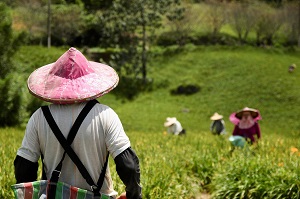![]() Labor Shortages in Agriculture is a news and information topic monitored and covered by: Prepper Watch – Food Concerns
Labor Shortages in Agriculture is a news and information topic monitored and covered by: Prepper Watch – Food Concerns
Introduction
As the world faces a range of challenges—from climate change and technological disruptions to economic volatility—agriculture remains a cornerstone of human survival. However, there’s an increasingly alarming trend that could significantly impact global food production: labor shortages in agriculture.
A declining workforce in farming, planting, harvesting, and food processing is threatening the capacity to produce the food we rely on, particularly in rural and farming areas. For preppers, who prioritize self-sufficiency and sustainability, this labor shortage can have a profound effect on food security.
This comprehensive guide explores how preppers can proactively plan for agricultural labor shortages, ensuring that their food supplies, growing capacities, and survival strategies are resilient in the face of these challenges.
Understanding the Labor Shortage in Agriculture
Before diving into the practical measures preppers can take, it’s crucial to understand the underlying causes of the labor shortage in agriculture.
Causes of Labor Shortages
Several factors contribute to the current and future agricultural labor shortages:
- Aging Workforce: Many farm workers are aging, and there is a lack of younger workers entering the field. As older generations retire, there are fewer people willing to take on farm labor.
- Low Wages: The financial compensation for agricultural workers is often low, making these jobs less attractive compared to other industries.
- Immigration Restrictions: Many agricultural sectors depend on migrant labor, and restrictions on immigration have resulted in a decrease in the number of workers available for farm labor.
- Urbanization and Lifestyle Preferences: Young people moving to cities for better job opportunities and a different lifestyle means fewer are returning to rural areas to work in agriculture.
- Health Risks: The COVID-19 pandemic highlighted the vulnerability of farmworkers, with many fearing for their health as essential workers.
These factors combined suggest that the shortage is not a temporary issue. It’s a growing concern that will likely worsen in the coming years, making it critical for preppers to take proactive steps to ensure that they can produce, store, and process food without depending on external labor.
Planning Your Own Agricultural Workforce
Labor shortages in agriculture necessitate a shift in how preppers approach their food production systems. Rather than relying on hired labor, preppers can start by making their own agricultural operations as self-sufficient as possible.
Build a Diversified, Scalable Farm System
One of the most effective ways to overcome a potential labor shortage is by diversifying your farm operation. This way, you won’t be relying on a single type of crop or livestock that might require specialized labor. Consider the following:
- Grow a Variety of Crops: Diversifying your crops ensures that you’re less vulnerable to supply chain disruptions. It also means you’ll be better prepared to handle fluctuations in labor availability, as some crops may require less intense labor than others.
- Choose Low-Maintenance Crops: Perennial crops such as asparagus, rhubarb, and certain fruit trees often require less annual labor. Consider planting crops that will reduce the need for frequent replanting and high labor intensity.
- Plan for Livestock: Raising animals like chickens, goats, or pigs can be relatively low-maintenance and offers food production without relying heavily on labor. Furthermore, livestock can help maintain soil health and contribute to long-term sustainability.
Mechanization to Reduce Labor Needs
Mechanizing certain aspects of farming can significantly reduce the amount of physical labor required. For example:
- Automated Planters and Harvesters: In large-scale farms, there are machines that can plant and harvest crops like potatoes, corn, and wheat. For smaller-scale operations, these machines may be cost-prohibitive, but exploring smaller alternatives like walk-behind tractors or automated garden systems could be beneficial.
- Watering Systems: Drip irrigation systems can automate the process of watering crops, saving time and labor. Using solar-powered irrigation can further align with prepping goals by reducing reliance on external energy sources.
- Processing Equipment: Food processing is often a labor-intensive task, but it can be made more manageable by investing in equipment like dehydrators, freeze-dryers, and canning machines.
By investing in mechanization, preppers can reduce their dependence on an external labor force while ensuring their food production remains efficient and effective.
Building Community-Based Labor Solutions
Even though preppers often focus on self-sufficiency, agriculture is a communal effort that often requires shared resources. When preparing for labor shortages in agriculture, it’s crucial to build community-based solutions that enable sharing of resources, labor, and expertise.
Forming Local Agricultural Co-Ops
A key solution to labor shortages is forming a cooperative. Local co-ops can share resources, machinery, and labor, ensuring that everyone in the community has the tools and assistance needed for planting, maintaining, and harvesting crops. Co-ops can also help reduce costs and offer training in new technologies and farming methods.
- Shared Equipment: By pooling resources, members of a co-op can invest in expensive machinery like tractors, harvesters, or irrigation systems, which can then be shared across the community.
- Labor Sharing: Members of the co-op can share labor during peak planting and harvest times. By creating a fair system for dividing labor, communities can ensure that no one is overburdened while maximizing the amount of work accomplished during labor shortages.
- Skills Training: A co-op can provide workshops and training sessions to teach skills like farming, animal husbandry, and food preservation. By educating people in the community, you create a workforce that is better equipped to handle the challenges of food production, even in times of labor shortages.
Mutual Assistance Groups (MAGs)
In the event of labor shortages, preppers in a MAG can come together to support each other by sharing food, tools, and manpower. MAGs are already based on mutual aid, so they are naturally aligned with preparing for labor shortages. By maintaining a diverse group of people with different skills, MAGs can pool their resources and manage agricultural labor more effectively.
Maximizing Home and Small-Scale Agriculture
One of the most straightforward ways to prepare for agricultural labor shortages is to maximize the productivity of small-scale and home-based farming systems. Even if you only have a small plot of land or live in an urban environment, there are still many steps you can take to reduce dependency on external food sources.
Backyard Gardening
A home garden doesn’t have to be large to produce significant yields. Many preppers start with small raised beds or container gardens that require minimal labor while producing a variety of vegetables, fruits, and herbs. This can be an essential step in reducing your reliance on outside agricultural workers.
- Square Foot Gardening: This method of gardening focuses on maximizing space by planting a variety of crops in small, efficient spaces. It requires minimal maintenance and yields high quantities of food per square foot.
- Vertical Gardening: Vertical gardens use structures like trellises and towers to grow plants upwards, saving space and reducing labor. You can grow everything from tomatoes to beans to leafy greens in vertical gardens.
- Hydroponics and Aquaponics: These soil-less gardening methods allow you to grow crops indoors or in small spaces. With hydroponics, plants grow in water and nutrients, while aquaponics integrates fish to create a self-sustaining ecosystem.
Livestock in Small Spaces
Raising small livestock, like chickens, rabbits, or even goats, is an excellent way to bolster your food security. These animals can be raised in small backyards or on small properties and require relatively low labor to manage. Chickens provide eggs and meat, goats provide milk and fiber, and rabbits are a great source of protein.
- Chicken Tractors: These are mobile chicken coops that allow chickens to graze in different areas, reducing the need for intensive labor while improving soil quality.
- Composting with Livestock: Animal waste from small livestock can be composted and used to fertilize crops, creating a self-sustaining cycle of food production and waste management.
Reducing Reliance on Outside Food Sources
Labor shortages in agriculture can create disruptions in food supply chains. To prepare for such disruptions, preppers can take steps to reduce reliance on external food sources.
Stockpiling and Food Preservation
Stockpiling food is an essential prepper strategy, especially when considering potential agricultural labor shortages. By storing non-perishable food, you can ensure that you have enough food to weather periods of food scarcity.
- Canning and Freezing: Learn how to can and freeze surplus produce from your own garden or local farmers’ markets. This extends the shelf life of fruits, vegetables, meats, and even dairy products.
- Dehydrating: Dehydrating fruits, vegetables, meats, and herbs is another great way to preserve food for long-term storage. A good dehydrator or access to solar drying methods can provide an abundance of preserved food.
- Fermentation: Fermenting vegetables, fruits, and dairy is an ancient food preservation method that also provides nutritional benefits, such as probiotics.
Foraging
As part of your strategy to reduce reliance on external food sources, foraging can supplement your food stores. By learning about wild edible plants and mushrooms, you can gain an additional layer of self-sufficiency.
- Medicinal Plants: Many wild plants have medicinal properties, which can reduce your reliance on pharmaceutical sources.
- Edible Wild Foods: Knowing what wild plants and fruits are edible in your area can provide an emergency food source in the event of a severe labor shortage.
Preparing for the Future
The current trends of labor shortages in agriculture are unlikely to reverse anytime soon. As such, it’s critical that preppers take proactive steps to ensure their food security, self-sufficiency, and resilience in the face of an uncertain future.
- Invest in Education: Continue learning about sustainable farming techniques, permaculture, food preservation, and animal husbandry. Knowledge is the ultimate tool to ensure you can adapt to changing conditions.
- Advocate for Policy Changes: Preppers should also consider advocating for policy changes that promote better working conditions for agricultural workers, immigration reform that addresses labor shortages, and incentives for automation and mechanization in farming.
Conclusion
Labor shortages in agriculture present a unique challenge, but they are not insurmountable. By adopting self-sufficiency practices, diversifying your food production, investing in mechanization, and building strong community support systems, preppers can navigate these challenges effectively.
Preparing for agricultural labor shortages ensures that no matter what challenges lie ahead, you’ll have the resources and strategies necessary to thrive in a world that may be increasingly uncertain.

